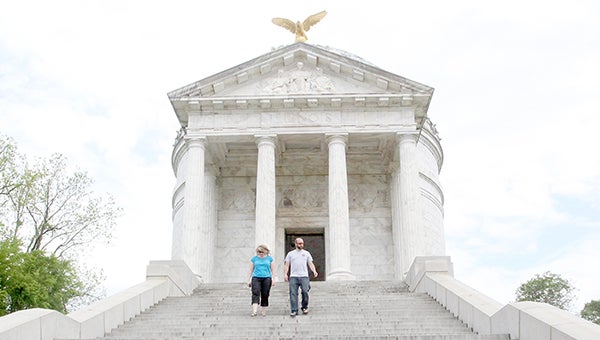VNMP host to many unique monuments
Published 9:21 am Monday, April 25, 2016

- TAKING IN HISTORY: Visitors leave the Illinois memorial at the Vicksburg National Military Park during National Parks Week. The Illinois memorial is the largest and one of the more popular features of the VNMP.
Visitors travel the Vicksburg National Military Park’s tour road to gauge the aesthetics of the park.
Once inside, visitors are greeted by alluring monuments on an open field of green pastures.
Of all the monuments inside the park, some are more adored than others. Terry Winschel spent 35 years working with the VNMP as a historian and pointed out which monuments and memorials visitors looked at the most.
Beginning with the first stop on the VNMP’s tour road is the Illinois memorial. Winschel said it was patterned after the Roman Pantheon and local refer to it as the “echo house,” because of the echo visitors get when inside the rotunda.
Inside the memorial are the names of the 36,325 soldiers who fought in Vicksburg
“Illinois is by far, the most popular,” Winschel said. “It’s the largest, most ornate monument on the grounds of the national park. Dedicated in 1906, the state memorial cost $195,000.”
To put things in perspective, Winschel said that when the legislature made this appropriation in 1904 it represented 20 percent of the state’s budget.
“I think that speaks volumes of how significant the people of Illinois viewed the participation of its soliders in this campaign,” Winschel said.
Moving along the tour road, visitors meet the Wisconsin monument, which was dedicated in 1911.
Winschel said the Wisconsin was accepted on behalf of the federal government by Maj. Gen. Frederick D. Grant, son of Ulysses S. Grant. He added that Frederick was a 12-year-old boy when the siege of Vicksburg happened and was a combat-wounded veteran during this campaign.
“When these monuments are dedicated, they are first of all presented to the governor of that respected state,” Winschel said. “Then it is presented by the governor or his representative to the United States Government and Fred Grant would accept that monument on behalf of the federal government.
“Once it is accepted by the federal government, it becomes a federal responsibility to maintain these monuments.”
The next monument of interest to visitors would be the African-American monument near Sherman Avenue. This monument represents all African-Americans Mississippians who fought in the war.
It was dedicated in 2004 and Winschel is excited for what it represents.
“I tell folks all the time I think it speaks volumes how far this state has come in terms of race relations that a state of the former Confederacy, appropriated a quarter of a million dollars to erect a monument honoring black troops in Union blue who served in occupation of one of the state’s largest cities,” Winschel said.
Continuing along the tour arrives the statue of Union commander Ulysses S. Grant on his horse named Kangaroo. Winschel said Grant was an expert horseman and loved riding difficult horses, which Kangaroo was because of its hop opposed to a smooth canter.
The Navy monument would be next of Winschel’s list of popular monuments in the park, as it is the tallest in the park measuring 202-feet in the air. Around the base of the monument are statues of four prominent Naval officers who served in the campaigns of 1862 and 1863.
It’s quiet noted that the American Civil War tore apart families and pitted brother against brother. On the confederate side of the park is a monument remembering those on both sides of the war.
The Missouri monument’s central feature is an angle known as “The Spirit of the Republic.”
“This particular monument has two panels on it. On one side it is titled ‘The defense,’ the other is ‘The Attack.’ These depict Union soldiers from Missouri attacking this very position, defended by soldiers from Missouri,” Winschel said. “Those Missouri regiments – one in Union blue, the other in Confederate gray – had been recruited in the same county as the other to show that the Civil War was a war where brother fought brother.”
Atop of the highest point of Warren County sits the Louisiana monument, which was dedicated in 1920.
“It’s a column with a flaming brazier made of granite on top to symbolize an internal flame of piece,” Winschel said. “Unfortunately, that monument got struck by lighting in 1999 and had to be disassembled. It was the only time in the history of this national park that a state monument had to be dismantled.”
Coming full circle, the Mississippi monument is really popular among Mississippians who visit the park.
“Artistically, it is a beautiful monument that features bronze figures, clusters of soldiers fighting and relief portraits behind them,” Winschell said. “It ends up that the bronze was nothing but foundry scrap and it has not weathered well over the years.”





